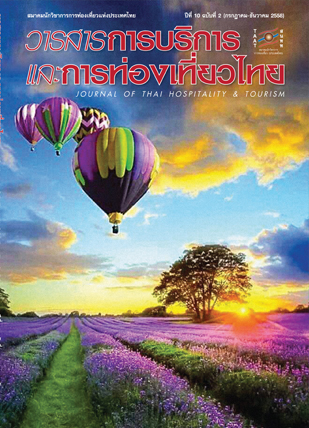กลยุทธ์การนำเสนอสารประชาสัมพันธ์การท่องเที่ยวในวันแห่งความรักของการท่องเที่ยวแห่งประเทศไทย
Main Article Content
บทคัดย่อ
บทความนี้มุ่งวิเคราะห์กลยุทธ์การนำเสนอสารประชาสัมพันธ์การท่องเที่ยวในวันแห่งความรักของการท่องเที่ยวแห่งประเทศไทย เก็บข้อมูลจากข่าวประชาสัมพันธ์การท่องเที่ยวในวันแห่งความรักในปี พ.ศ. 2557 และ 2558 ของการท่องเที่ยวแห่งประเทศไทยที่เผยแพร่ในเว็บไซต์ ผลการศึกษาพบกลยุทธ์ได้แก่ (1) กลยุทธ์การสร้างสารสำหรับกลุ่มเป้าหมาย (2) กลยุทธ์การนำเสนอข้อเท็จจริงโดยเชื่อมโยงแนวคิดของงานกับแหล่งท่องเที่ยว (3) กลยุทธ์การใช้บุคคลมีชื่อเสียงเพื่อผลทางการตลาด (4) กลยุทธ์การโน้มน้าวใจ (5) กลยุทธ์การนำเสนอสารด้วยการใช้ภาษาสร้างสรรค์และ (6) กลยุทธ์การสร้างภาพลักษณ์
Article Details
รูปแบบการอ้างอิง
Bunnag, O. (2016). กลยุทธ์การนำเสนอสารประชาสัมพันธ์การท่องเที่ยวในวันแห่งความรักของการท่องเที่ยวแห่งประเทศไทย. วารสารการบริการและการท่องเที่ยวไทย, 10(2), 34–46. สืบค้น จาก https://so04.tci-thaijo.org/index.php/tourismtaat/article/view/45400
ประเภทบทความ
บทความวิจัย
เอกสารอ้างอิง
[1] กรรณิการ์ อัศวดรเดชา. (2550). การสื่อสารเพื่อการโน้มน้าวใจ. กรุงเทพฯ: จุฬาลงกรณ์มหาวิทยาลัย.
[2] การท่องเที่ยวแห่งประเทศไทย. (2556). ททท.ใช้วิถีความเป็นไทยเพิ่มรายได้ให้ได้ 2.2 ล้านล้านในปี 58. สืบค้นเมื่อวันที่ 2 มีนาคม 2558, จาก https://tourisminvest.tat.or.th
[3] การท่องเที่ยวแห่งประเทศไทย. (2557). แผนการตลาดท่องเที่ยวททท. ภูมิภาคกลางปี 2557. สืบค้นเมื่อวันที่ 18 มกราคม 2557, จาก https://www.tiewpakklang.com/news/central-region/10135/.
[4] การท่องเที่ยวแห่งประเทศไทย. (2557). ข่าวอัพเดท. สืบค้นเมื่อวันที่ 18 กุมภาพันธ์ 2557, จาก https://thai.tourismthailand.org
[5] การท่องเที่ยวแห่งประเทศไทย. (2558). ข่าวอัพเดท. สืบค้นเมื่อวันที่ 16 กุมภาพันธ์ 2557, จาก https://thai.tourismthailand.org
[6] จินตวีร์ เกษมศุข. (ม.ป.ป.). หลักการและกลยุทธ์ในการประชาสัมพันธ์. เอกสารประกอบการเรียนรู้ด้วยตนเอง หมวดวิชางานชุมชนและมวลชนสัมพันธ์ สาขาวิชาการประชาสัมพันธ์ คณะนิเทศศาสตร์ มหาวิทยาลัยศรีปทุม. สืบค้นเมื่อวันที่ 2 กรกฎาคม 2557, จาก https://www.stou.ac.th/offices/Oce/kmoce1/pr249561.pdf
[7] ชนกพล ชัยรัตนศักดา. (2556). ประสิทธิภาพของสื่อประชาสัมพันธ์ด้านการท่องเที่ยวในประเทศไทย. การศึกษาค้นคว้าอิสระ หลักสูตรนิเทศศาสตรมหาบัณฑิต สาขาการประชาสัมพันธ์, มหาวิทยาลัยศรีปทุม.
[8] ชรินทร์ อยู่เพชร. (2555). การเติบโตอย่างรวดเร็วของ Slow Tourism. Tourism and Hospitality Management Quarterly Review, 5, 5-6.
[9] ชาย โพธิสิตา. (2556). ศาสตร์และศิลป์แห่งการวิจัยเชิงคุณภาพ. กรุงเทพฯ: อมรินทร์พริ้นติ้งฯ.
[10] พรทิพย์ พิมลสิทธุ์. (2542). แนวทางการติดตามและประเมินผลการประชาสัมพันธ์. กรุงเทพฯ: มหาวิทยาลัยธรรมศาสตร์.
[11] พิชัย นิรมานสกุล. (2555). การรับรู้ภาพลักษณ์แบรนด์เมืองท่องเที่ยวไทย. วารสารวิชาการมหาวิทยาลัยหอการค้าไทย, 32(4), 82-101.
[12] รุ่งนภา พิตรปรีชา. (2556). พลังแห่งการประชาสัมพันธ์. กรุงเทพฯ: โครงการตำราคณะนิเทศศาสตร์ จุฬาลงกรณ์มหาวิทยาลัย.
[13] รุ่งรัตน์ ชัยสำเร็จ. (2546). การเขียนเพื่อการประชาสัมพันธ์. กรุงเทพฯ: สำนักพิมพ์แห่งจุฬาลงกรณ์มหาวิทยาลัย.
[14] ศรีกัญญา มงคลศิริ. (2547). Celebrity Marketing. กรุงเทพฯ: Higher Press.
[15] ศิวกานท์ ปทุมสูติ. (2548). การเขียนสร้างสรรค์ไม่ยากอะไรเลย. กรุงเทพฯ: นวสาส์นการพิมพ์.
[16] INCquity. (2555). Celebrity Marketing การตลาดบนพรมแดงและแสงแฟลช. สืบค้นเมื่อวันที่ 2 มีนาคม 2557, จาก https://incquity.com/articles/marketing-boost/celebrity-marketing
[17] Carmen, M.I. (2009). The Importance Planning of Public Relations in Tourist Organizations' Communication. Management, 12(2), 239-248.
[18] Newlands, M. (2014). Why Public Relations is Important for Your Business. Retrieved March 2, 2015, from https://www.inc.com/murray-newlands/why-public-relations-is-important-for-your-business.html
[2] การท่องเที่ยวแห่งประเทศไทย. (2556). ททท.ใช้วิถีความเป็นไทยเพิ่มรายได้ให้ได้ 2.2 ล้านล้านในปี 58. สืบค้นเมื่อวันที่ 2 มีนาคม 2558, จาก https://tourisminvest.tat.or.th
[3] การท่องเที่ยวแห่งประเทศไทย. (2557). แผนการตลาดท่องเที่ยวททท. ภูมิภาคกลางปี 2557. สืบค้นเมื่อวันที่ 18 มกราคม 2557, จาก https://www.tiewpakklang.com/news/central-region/10135/.
[4] การท่องเที่ยวแห่งประเทศไทย. (2557). ข่าวอัพเดท. สืบค้นเมื่อวันที่ 18 กุมภาพันธ์ 2557, จาก https://thai.tourismthailand.org
[5] การท่องเที่ยวแห่งประเทศไทย. (2558). ข่าวอัพเดท. สืบค้นเมื่อวันที่ 16 กุมภาพันธ์ 2557, จาก https://thai.tourismthailand.org
[6] จินตวีร์ เกษมศุข. (ม.ป.ป.). หลักการและกลยุทธ์ในการประชาสัมพันธ์. เอกสารประกอบการเรียนรู้ด้วยตนเอง หมวดวิชางานชุมชนและมวลชนสัมพันธ์ สาขาวิชาการประชาสัมพันธ์ คณะนิเทศศาสตร์ มหาวิทยาลัยศรีปทุม. สืบค้นเมื่อวันที่ 2 กรกฎาคม 2557, จาก https://www.stou.ac.th/offices/Oce/kmoce1/pr249561.pdf
[7] ชนกพล ชัยรัตนศักดา. (2556). ประสิทธิภาพของสื่อประชาสัมพันธ์ด้านการท่องเที่ยวในประเทศไทย. การศึกษาค้นคว้าอิสระ หลักสูตรนิเทศศาสตรมหาบัณฑิต สาขาการประชาสัมพันธ์, มหาวิทยาลัยศรีปทุม.
[8] ชรินทร์ อยู่เพชร. (2555). การเติบโตอย่างรวดเร็วของ Slow Tourism. Tourism and Hospitality Management Quarterly Review, 5, 5-6.
[9] ชาย โพธิสิตา. (2556). ศาสตร์และศิลป์แห่งการวิจัยเชิงคุณภาพ. กรุงเทพฯ: อมรินทร์พริ้นติ้งฯ.
[10] พรทิพย์ พิมลสิทธุ์. (2542). แนวทางการติดตามและประเมินผลการประชาสัมพันธ์. กรุงเทพฯ: มหาวิทยาลัยธรรมศาสตร์.
[11] พิชัย นิรมานสกุล. (2555). การรับรู้ภาพลักษณ์แบรนด์เมืองท่องเที่ยวไทย. วารสารวิชาการมหาวิทยาลัยหอการค้าไทย, 32(4), 82-101.
[12] รุ่งนภา พิตรปรีชา. (2556). พลังแห่งการประชาสัมพันธ์. กรุงเทพฯ: โครงการตำราคณะนิเทศศาสตร์ จุฬาลงกรณ์มหาวิทยาลัย.
[13] รุ่งรัตน์ ชัยสำเร็จ. (2546). การเขียนเพื่อการประชาสัมพันธ์. กรุงเทพฯ: สำนักพิมพ์แห่งจุฬาลงกรณ์มหาวิทยาลัย.
[14] ศรีกัญญา มงคลศิริ. (2547). Celebrity Marketing. กรุงเทพฯ: Higher Press.
[15] ศิวกานท์ ปทุมสูติ. (2548). การเขียนสร้างสรรค์ไม่ยากอะไรเลย. กรุงเทพฯ: นวสาส์นการพิมพ์.
[16] INCquity. (2555). Celebrity Marketing การตลาดบนพรมแดงและแสงแฟลช. สืบค้นเมื่อวันที่ 2 มีนาคม 2557, จาก https://incquity.com/articles/marketing-boost/celebrity-marketing
[17] Carmen, M.I. (2009). The Importance Planning of Public Relations in Tourist Organizations' Communication. Management, 12(2), 239-248.
[18] Newlands, M. (2014). Why Public Relations is Important for Your Business. Retrieved March 2, 2015, from https://www.inc.com/murray-newlands/why-public-relations-is-important-for-your-business.html


